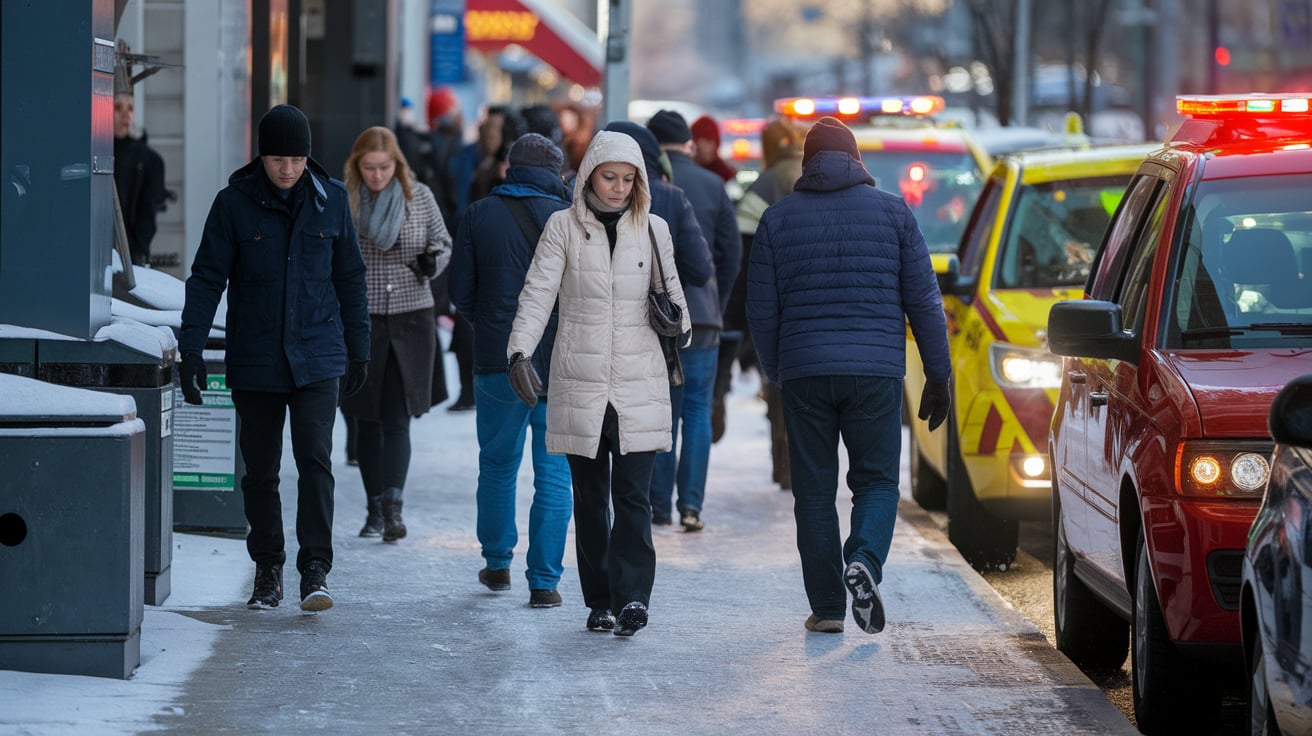A Comprehensive Guide for NYC Residents
Slip, trips, and falls are common occurrences in New York City due to the bustling streets, busy intersections, snowy weather, and heavy pedestrian congestion. Unfortunately, these incidents can have serious consequences, including death. In fact, the CDC reports that slip-and-fall accidents accounted for at least 38,000 deaths in 2021 among adults aged 65 and older.
This article will explain the legal framework that victims of slips, trips, and falls can follow after their accident. We will discuss the appropriate steps to secure compensation and help you get your life back on track following a NYC slip-and-fall incident. If you need legal help after a trip and fall, our dedicated attorneys are here to assist you in securing maximum compensation for your injuries.
Understanding the Scope: NYC Slip and Fall Accidents
Slip-and-fall accidents have many causes, but they all share one thing in common: devastating effects on the victims. These accidents can occur while walking on sidewalks, crossing the street, catching the train, or in many other situations. When they happen, it’s essential to know who to hold accountable and how much compensation you can potentially recover.
What Are the Most Common Causes of NYC Slip, Trip, and Fall Accidents?
While there are many potential causes of slip, trip, and fall accidents in NYC, some occur more often than others. Understanding these common causes can help NYC residents and visitors reduce their risk of being a victim of a slip-and-fall accident and mitigate the negative consequences that follow a personal injury.
Poorly Maintained Sidewalks
According to NYC Planning, the population of the Big Apple was nearly 9 million as of 2020. With that number expected to grow, foot traffic in the city is at an all-time high. As a result of high foot traffic and natural weather conditions, sidewalks can rapidly deteriorate and become more of a safety hazard than a safe haven for pedestrians.
There are many ways that a sidewalk can be poorly maintained. Sometimes, sidewalks are constructed on uneven surfaces, increasing the likelihood of pedestrians stumbling while traversing them. Uneven sidewalks become especially problematic when weather conditions create slippery surfaces, often leading to disastrous falls.
Sidewalks can also become cracked from years of use, weathering or tree roots which force concrete slabs to become uneven. When cracks or uneven sidewalks appear, it becomes easy for pedestrians to get their feet stuck, leading to injuries like ankle sprains and fractures.
Another factor contributing to poorly maintained sidewalks is the sheer amount of construction occurring in the city at any given moment. Construction projects often lead to increased debris and tripping hazards, such as dirt and tools, that pose serious risks to pedestrians.
Inclement Weather
Snow, ice, rain, and other inclement weather conditions significantly contribute to slip-and-fall accidents in NYC. These weather conditions can cause walking surfaces to become slippery and challenging to navigate. This is especially true when snow compacts and forms a thin layer of ice on the sidewalk.
Icy conditions reduce the friction between shoes and the sidewalk, causing pedestrians to lose balance and fall. It’s also important to note that walking during severe snow or rain storms can reduce visibility and cause pedestrians to encounter otherwise avoidable hazards.
Dangerous Subway Conditions
New York City commuters rely heavily on the subway to get around the city. While it is a convenient means of transportation, slips, trips, and falls are common on the subway and in subway stations for various reasons. Commuters often injure themselves while using stairs, escalators, or rushing to catch their train.
Subway floors often become wet due to spilled drinks or water from wet shoes, especially during damp weather. When subway floors are wet, they pose a severe hazard to commuters who risk slipping on the hard station floors. Once on the train, sudden stops, sudden acceleration, and a lack of seating can cause commuters to stumble and fall.
How Do I Know If I Have a Valid Legal Case?
It’s understandable to seek legal compensation following a slip and fall that caused injury. The first step is to determine whether you may have a valid case. Speaking to a personal injury attorney is crucial to know if your personal injury case holds merit.
Put simply, determining if you have a legal case requires proving negligence. Victims must establish that property owners (or the city) were negligent by knowingly allowing a dangerous condition to exist on their property without addressing it. If that dangerous condition led to your injuries, you may have a claim.
What to Do Immediately After a Slip and Fall Accident in New York City
Get Medical Help
Get medical help immediately after your fall, even if you don’t feel injured. Head, neck, and spinal injuries can show delayed symptoms. Prompt diagnosis can prevent further harm, especially in cases of traumatic brain injuries like concussions. If you cannot move safely from the scene, call 911 or ask a bystander to help you. Don’t attempt to move by yourself if you are experiencing excruciating pain or dizziness.
Obtain and maintain records of every diagnosis, treatment plan, and follow-up visit throughout your treatment. These records will be crucial when proving that your slip-and-fall accident caused your injury and that you didn’t have any pre-existing conditions before the incident.
Document the Scene
Documenting the scene of your accident will serve as decisive proof of the conditions that caused you to fall. Consider using your phone or asking someone else to take pictures and videos of the area where you fell.
Focus on the hazardous conditions that led to your fall. For example, if a cracked sidewalk caused your fall, zoom in on the cracked area to clearly show the defective condition. Make sure that the recording device you use can show the time and date the images were captured.
Take Steps to Preserve Evidence
Preserving evidence of the scene, including firsthand witness accounts of what happened, is key. Request the contact information (phone numbers and email addresses) of bystanders who saw the accident occur or witnessed the hazardous conditions. Their testimony will support your version of events should disputes arise regarding the cause of your fall, which is highly likely when dealing with opposing lawyers and insurance companies.
Keep the clothing and footwear you wore during the accident in the same condition as when the fall occurred. Chances are that opposing lawyers will ask you about the clothing you wore when the accident happened. It’s best to have these items available if they request them during discovery.
Hold on to any medical receipts and maintain copies of all correspondence with property owners or insurance companies. These documents will help prove the damages you suffered and support your good faith efforts in alerting property owners following your accident.
Understanding Premises Liability in NYC
In NYC, property owners or occupiers must maintain sidewalks in a reasonably safe condition. Under New York City Administrative Code § 7-210, this duty has been partially shifted from the City of New York to the property owners. Owners are generally required to keep their bordering sidewalks free from hazards that could lead to accidents.
Certain property owners must install, repair, or replace defective sidewalk flags and promptly address winter weather conditions. Failure to do so could result in liability for personal injuries. One-, two-, or three-family homes used exclusively for residential purposes often do not carry the same liability exposure under this code.
The Administrative Code also contains sections such as § 19-152, § 19-152.2, and § 19-152.3. These provisions cover how property owners should respond to notices of defect, how injured parties can file claims, and the process for appealing or reviewing findings. Despite the code’s exemptions for certain residential buildings, the overarching goal is to ensure that pedestrians face fewer hazards and that injured individuals have clear legal avenues to seek damages if a property owner fails to uphold that duty.
How Does the Settlement Process Work?
In any slip and fall or similar premises liability claim, the concepts of duty of care, negligence, insurance, and settlement are involved. Duty of care refers to the property owner’s obligation to keep their property safe. Negligence arises when the property owner knew or should have known about a hazardous condition and did not remedy it.
The next step usually involves insurance if a plaintiff can demonstrate that the property owner’s negligence caused their injuries. Most property owners carry liability insurance to cover these risks. Once a claim is filed, an insurance adjuster will typically investigate how the accident occurred and whether the owner was at fault.
Once insurance gets involved, the next step is settlement negotiations. Settlements can save both parties time and money by avoiding substantial litigation costs such as attorneys’ fees and court costs. Fair settlements compensate for medical expenses, lost wages, and pain and suffering. However, the injured individual should be cautious about low-ball offers from insurance companies that are far less than what victims could receive from taking appropriate legal action.
How Does the Legal Process Work Following Settlement Talks?
When parties settle, the process involves finalizing paperwork and disbursing the agreed-upon compensation. The injured individual signs a release from pursuing further claims arising from the same incident. In some cases, health insurers or government agencies that covered the plaintiff’s medical expenses may have liens on the settlement funds.
If the parties do not settle, the legal process continues. The plaintiff files a summons and complaint, initiating the lawsuit and outlining the allegations against the defendant. If the entity involved is a public body such as the City of New York or the Metropolitan Transportation Authority (MTA), additional requirements come into play. Under New York’s General Municipal Law, an injured party pursuing a claim against a municipality must file a notice of claim within ninety days of the incident. The notice of claim sets forth the nature of the claim and preserves the plaintiff’s rights to sue.
Both sides engage in the discovery phase, which includes exchanging evidence, depositions, and possibly retaining experts. At any point, the case may still settle based on newly uncovered evidence or move toward trial if neither party compromises. During the trial, each side presents witnesses and arguments to a judge or jury, who then determines whether the defendant is liable and the damages the plaintiff should receive.
How Can a Lawyer Help Following a NYC Slip and Fall Accident
Lawyers are valuable advocates following any personal injury. Not only do they have the skills needed to negotiate with insurance companies, but they also know how to navigate the legal process should negotiations falter. A skilled personal injury attorney can:
- Investigate the Scene. Attorneys understand what to look for when investigating an accident scene. They know what common accident causes contribute to slip-and-falls and how to identify them. They are also familiar with what evidence will be persuasive to a jury. They may retain the services of expert witnesses to strengthen your claims.
- Negotiate with Insurance Companies. Insurance companies are infamous for offering low-ball settlements to accident victims. An experienced attorney will understand the true value of your claim and will know what an acceptable offer from the insurance company should include. While you will always have the final say in accepting an offer, your attorney will provide their professional opinion.
- Handle the Legal Paperwork. All lawsuits involve extensive paperwork. From initial pleadings to summary judgment motions and everything in between, your attorney will ensure that your legal paperwork is prepared and filed on time and correctly.
- Present Your Case at Trial. If necessary, your attorney will zealously advocate for you before the judge and jury, presenting a compelling case for the injuries you suffered and the compensation you deserve.
While you do not technically need an attorney to handle your personal injury case, having one can make a significant difference in the compensation you receive. With a trained professional handling your claim, you can rest assured that important deadlines won’t be missed and that the best legal arguments will be made on your behalf.
How Much Is My Slip and Fall Claim Worth?
The potential value of your claim varies widely. Certain factors that contribute to the value of your claim include the type and severity of the injury, the varying degrees of fault of the parties involved, as well as the long-term consequences on your life and earning potential.
Traumatic brain injuries often carry a high level of compensation because they can lead to long-term debilitating symptoms that significantly limit a person’s ability to work or engage in daily activities.
Fractures, including broken wrists, hips, or vertebrae, also tend to increase a claim’s worth because they frequently require surgery and prolonged time away from employment. Beyond the physical harm, a plaintiff may claim loss of enjoyment of life if their injuries prevent them from pursuing hobbies, spending time with family in the same manner, or otherwise living as they did before the accident.
Pain and suffering, which encompasses physical pain and emotional distress, is another critical component of a damages award. When evaluating these non-economic losses, New York courts consider factors such as the severity of pain, length of recovery, and potential for permanent limitations or disfigurement.
How Much Will My Slip and Fall Lawyer Cost?
Attorneys typically offer representation on a contingency fee basis. This arrangement means they only collect a fee if they secure a settlement or court award. The fee is usually one-third of the total recovery.
Under a contingency fee arrangement, clients are not responsible for hourly billing or upfront costs. However, case expenses—such as filing fees or expert witness costs—are typically reimbursed from any eventual settlement or collected judgment. Contingency fee arrangements help clients afford legal representation when they cannot work due to their injuries. They also provide lawyers with the incentive to secure the most compensation possible.
People Also Ask
What is negligence?
Negligence is a legal concept regarding when an individual can be responsible for your injuries. Negligence involves proving that a wrongdoer breached an owed duty of care to a victim, which caused the victim damages. Negligence claims are complicated and are best handled by legal professionals.
Is there a time limit for bringing my claim?
Yes. All legal claims are subject to legal time limits known as statutes of limitations. If a case is not brought within the applicable statute of limitations, the victim cannot seek legal compensation, regardless of the claim’s validity. Speak to an attorney to determine when to bring your NYC slip-and-fall case.
Can I sue more than one person or entity?
Yes. You can sue more than one responsible party. Oftentimes, multiple parties share fault for your accident, and they can all be held accountable in a lawsuit.
Can I Represent Myself?
Yes, you can represent yourself in a personal injury action. However, you will need to have a firm grasp of the legal process, including legal research and writing skills, to navigate your claim and secure compensation successfully. This may be especially difficult when recovering from injuries or if you lack familiarity with the legal process. It’s always best to consult with a licensed attorney to maximize your chances of a successful outcome.
Contact Our Dedicated Personal Injury Attorneys
At Dansker & Aspromonte Associates LLP, we have secured over a billion dollars worth of combined settlements for NYC accident victims. With over a century of combined experience handling personal injury claims, our team has the reputation and expertise to handle your claim and maximize your compensation. Contact us today for a no-cost consultation to discuss your legal options and take the first step towards justice.






